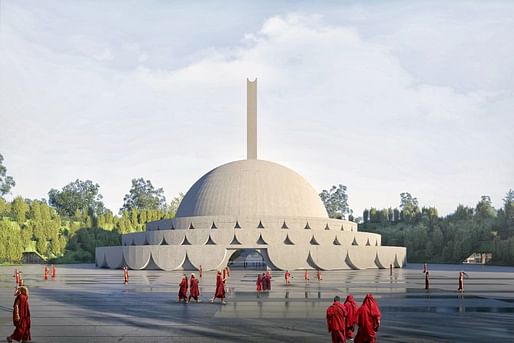
Stefano Boeri Architetti has unveiled a master plan to enhance the Ramagrama Stupa, one of the most significant places in the Buddhist world.
The site is located in Ramagrama, a municipality within the Parasi district in western Nepal. The archaeological destination dates back to the earliest period of the Buddhist tradition. It is covered by a hill and by the centuries-old Bodhi Tree, a sacred tree in Buddhism characterized by a high level of biodiversity. Under this lies a still intact Stupa of Buddha, which is a dirt burial mound faced with stone that contains portions of the relics of Buddha. Today, the site presents itself as a green mound.

Various organizations and Buddhist communities have committed themselves to the preservation and sustainable enhancement of the Ramagrama Stupa. The aim has been to conserve this site in accordance with the standards set by UNESCO for World Heritage Sites. Stefano Boeri Architetti has, thus, been entrusted with the design of the master plan of the site with the aim of both enhancing its role as an archaeological site and as a place for prayer, meditation, and peace.
The studio’s project develops around the Bodhi Tree and Stupa, maintaining a form of respectful distance to make the archaeological remains accessible for future research. The proposed design sets out to enhance the perception of the site’s uniqueness through a succession of spaces that highlight the symbolic significance of Ramagrama Stupa. They start from the four monumental portals that identify the four directions of access, up to the central hill.
The master plan includes what the firm calls the “Peace Meadow,” which serves as a central element. It is conceived as an open space for contemplation, with a ground design that references the mandala and the symbolic role of the place. The meadow is 600 meters (656 yards) in diameter and is surrounded by a circular system of facilities, cultural spaces, and areas for meditation and prayer.
This space is covered by the Biodiversity Ring Garden, which is designed as a slope hosting 80,000 plants of 70 different species, with plant varieties selected from native species from the Terai plain, the birthplace of Buddha.
The garden ends in a circular elevated pathway shaded by trees, offering a full view over the Ramagrama Stupa. The design takes the local climatic and environmental conditions into account through the intentional shading of pedestrian paths.
“This project represents an extraordinary challenge for us: That of creating a meaningful center for prayer, meditation, and peace in one of the most sacred sites of Buddhism,” said Stefano Boeri Architetti. “Due to its truly universal value and collaborative nature across cultures and nations, this project will become one of the most significant ongoing cultural heritage projects in Nepal.”

According to the architects, the master plan will be built using local materials aimed at reducing the environmental impact. It recalls the site’s architectural tradition by integrating the local production of bricks.
No Comments
Really? Apple Campus meets Buddhism?
Block this user
Are you sure you want to block this user and hide all related comments throughout the site?
Archinect
This is your first comment on Archinect. Your comment will be visible once approved.